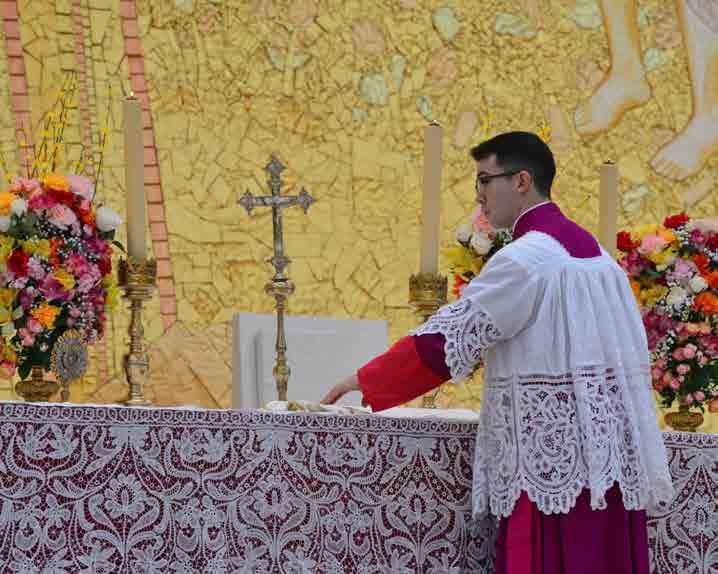FEATURE
The Sorrows of Mary Alan Frost on the history of settings of The Stabat Mater
T
he Stabat Mater, a mournful poem reflecting on the sorrows of Mary as her Son hung on the Cross, has been prayed since medieval times. It has also been set to music by many composers going back to the 1400s. The opening verse, which sets the tone, begins ‘Stabat mater dolorosa’, ‘the sorrowful mother stood’. In English it begins: ‘At the Cross her station keeping Stood the mournful mother weeping Close to Jesus to the last.’
The three-line structure of each verse and the metre closely resembles the funereal Dies Irae, Dies Illa. The Stabat Mater has one extra stanza. The whole of the text graphically describes the Mother of Christ at the foot of the Cross, a favourite theme of medieval piety. It was probably written by a Franciscan monk, Jacopone de Todi (1228-1306). Though this devotional poem has only been used as a sequence in the Roman Catholic liturgy to plainchant melody since 1727, composers had been setting the Blessed Virgin’s sorrow by the Cross to music much earlier, most notably Palestrina, the sixteenth century inspirer of so much polyphonic singing. A chorister himself in the major choirs of Rome, including the Pope’s own choir, the Capella Giulia, he wrote a great deal of sacred music, as did his Flemish contemporary (both died in 1594), Orlando Lassus, who also composed a Stabat Mater. As did Josquin des Pres, who was writing in the fifteenth century; an acknowledged master of polyphony before its development by the likes of Palestrina. Moving into the Baroque period, several settings of the Stabat Mater were written by the prolific opera composer Alessandro Scarlatti, who died in 1725, and one by his son Domenico, specifically for ten voices. Around this time another Italian, Giovanni Baptista Pergolesi, who died tragically young at 26, composed perhaps one of the most stunning settings of the work.
SPRING 2018
In 1735, a year before his death he moved to the Franciscan monastery at Pozzuoli, where he wrote his powerful interpretation of the poem. In 1767 the great Haydn composed his famous and lengthy setting, though only for a small orchestra and choir. Of this work he wrote: ‘I set to music with all my power the highly esteemed hymn called Stabat Mater.’ With Haydn’s work we see a devotional composition, but also the start of performance-for-audience. This was developed by Rossini who, by the age of 37 (in 1829), had composed almost all his great works including his last opera William Tell. But he had one great work left: his Stabat Mater. Its first performance (in 1842) was at the Paris Theatre and was an immediate success. Similar huge approval was witnessed two months later in its Italian debut conducted by Donizetti in Bologna. Set for four voices and choir it would not claim to probe the depths of human suffering, but surely conveys the joy of the believer at the prospect of redemption. As the last verse ‘Quando corpus morietur’ says, ‘when my body perishes, grant my soul the glory of Heaven.’ Another 19th century composer, whose reputation increased from his setting of the poem (in 1877), was Dvorak, the first Bohemian composer to achieve world-wide recognition. The Hungarian Liszt, who took minor Orders, set the Stabat Mater to music, as did a later Hungarian, Kodaly. Towards the end of the century, and towards the end of his life, the great opera composer Verdi wrote Four Sacred Pieces, the final one being the Stabat Mater, in 1896-7.
Elsewhere in Europe, the Irish composer Charles Stanford (1852-1924), included the Stabat Mater among his numerous choral settings. The coming of the twentieth century did not diminish the appeal of the Virgin’s sorrows to the composer. Arvo Part (born 1935) put Estonia on the musical map, and his religious compositions, notably his Stabat Mater, were critiques of the atheistic yoke his country was under for so long. His Polish contemporary Penderecki, made a setting of the work and of the Dies Irae dedicated to the memory of the victims of Auschwitz. Another Pole, less avant-garde than Penderecki, Symanowski, composed a setting of the Stabat Mater sung in his native tongue, first performed in Warsaw in 1929. Seventeen years later the English composer and convert Lennox Berkeley won much acclaim for his setting of the religious work. In France, a composer who made his name in the 1920s, Poulenc, set the work to music in 1950 following the death of a close friend. As recently as 2008, Karl Jenkins premiered his Stabat Mater, a composition about grief, in Liverpool, and even more recent (2016) is the setting of the Stabat Mater by the UK’s leading contemporary composer, Sir James MacMillan, a Patron of the Latin Mass Society. For more than seven hundred years, over 190 composers have reminded us through these settings of the grief of mothers everywhere. As the opening of the fifth verse, one of the most moving passages, asks: Quis est homo qui non fleret? Is there one who would not weep?
27

















